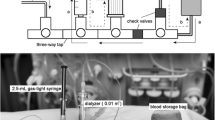Abstract
Babies weighing under 6 kg are difficult to dialyse, especially those as small as 1 kg. Peritoneal dialysis is easier than haemodialysis, but is not always possible, and clears molecules less efficiently. Two factors complicate haemodialysis. First, extracorporeal circuits are large relative to a baby’s blood volume, necessitating priming with fresh or modified blood. Second, blood flow from infants’ access vessels is disproportionately low (Poiseuille’s law), causing inadequate dialysis, or clotting within the circuit.
These problems are minimised by using single lumen access, a very small circuit, and a reservoir syringe to separate the sampling and dialyser blood flow rates. Its manual operation is tedious, so we developed a computer-controlled, pressure-monitored machine to run it, including adjusting the blood withdrawal rate from poorly sampling lines. We have dialysed four babies weighing 0.8–3.4 kg, with renal failure or metabolic disorders. The circuits did not require priming. Clearances of creatinine, urea, potassium, phosphate and ammonia were mean (SD) 0.54 (0.22) ml/min using one dialyser, and 0.98 (0.22) ml/min using two in parallel. Ammonia clearance in a 2.4 kg baby had a 9 h half-life. Ultrafiltration up to 45 ml/h was achieved easily. This device provided infants with immediate, effective and convenient haemodialysis, typically delivered for prolonged periods.








Similar content being viewed by others
References
Coulthard MG, Vernon B (1995) Managing acute renal failure in very low birth weight infants. Arch Dis Child Fetal Neonatal Ed 73:F187–192
Gitomer JJ, Khan AM, Ferris ME (2001) Treatment of severe theophylline toxicity with hemodialysis in a preterm neonate. Pediatr Nephrol 16:784–786
Pasko DA, Mottes TA, Mueller BA (2003) Pre dialysis of blood prime in continuous hemodialysis normalizes pH and electrolytes. Pediatr Nephrol 18:1177–1183
Coulthard MG, Sharp J (2001) Haemodialysing infants: theoretical limitations, and single versus double lumen lines. Pediatr Nephrol 16:332–334
Bock GH, Campos A, Thompson T, Maher SM, Kjellstrand CM (1981) Haemodialysis in the premature infant. Am J Dis Child 135:178–180
Coulthard MG (1989) Renal function. In: Harvey D, Cooke R, Levitt G (eds) The baby under 1000 g, 1st edn. John Wright, London, pp 211–225
Coulthard MG, Sharp J (1995) Haemodialysis and ultrafiltration in babies weighing under 1000 g. Arch Dis Child Fetal Neonatal Ed 73:F162–165
Medical Electrical Equipment (1990) Part 1: General requirements for safety. IEC 60601-1. British Standards Institute, London
Medical electrical equipment (1998) Part 2: Particular requirements for the safety of haemodialysis, haemodiafiltration and haemofiltration equipment. IEC 60601-2-16. British Standards Institute, London
Roberts M, Winney RJ (1992) Errors in fluid balance with pump control of continuous hemodialysis. Int J Artif Organs 15:99–102
Jenkins R, Harrison H, Chen B, Arnold D, Funk J (1992) Accuracy of intravenous infusion pumps in continuous renal replacement therapies. ASAIO J 38:808–810
De Virgiliis GM, Vanin M, Buoncristiani U (1985) A new single needle dialysis system. Trans Am Soc Artif Int Organs 31:116–118
De Wachter D, Verdonck P, Verhoeven R, Hombrouckx R (1993) Comparison of a new and a standard single-needle dialysis system using a mathematical model. Artif Organs 17:328–338
Hombrouckx R, Bogaert AM, Leroy F, Beelen R, De Vos JY, Van Overmeeren G, et al. (1989) Limitations of short dialysis are the indications for ultrashort daily auto dialysis. Trans Am Soc Artif Organs 35:503–505
Schaefer F, Straube E, Oh J, Mehls O, Mayatepek E (1999) Dialysis in neonates with inborn errors of metabolism. Nephrol Dialysis Transplant 14:910–918
Coulthard MG (1985) Maturation of glomerular filtration in preterm and mature babies. Early Hum Dev 11:281–292
Author information
Authors and Affiliations
Corresponding author
Rights and permissions
About this article
Cite this article
Everdell, N.L., Coulthard, M.G., Crosier, J. et al. A machine for haemodialysing very small infants. Pediatr Nephrol 20, 636–643 (2005). https://doi.org/10.1007/s00467-004-1785-5
Received:
Revised:
Accepted:
Published:
Issue Date:
DOI: https://doi.org/10.1007/s00467-004-1785-5




